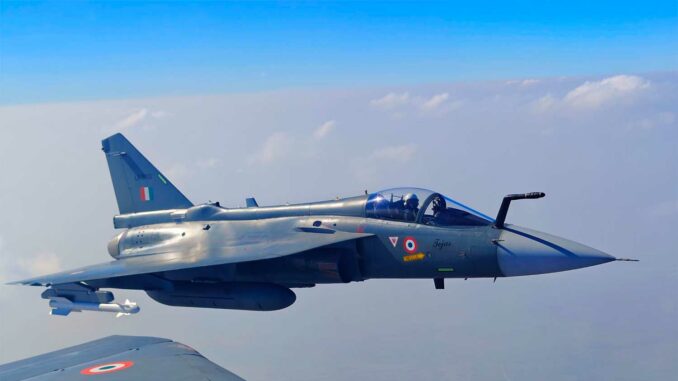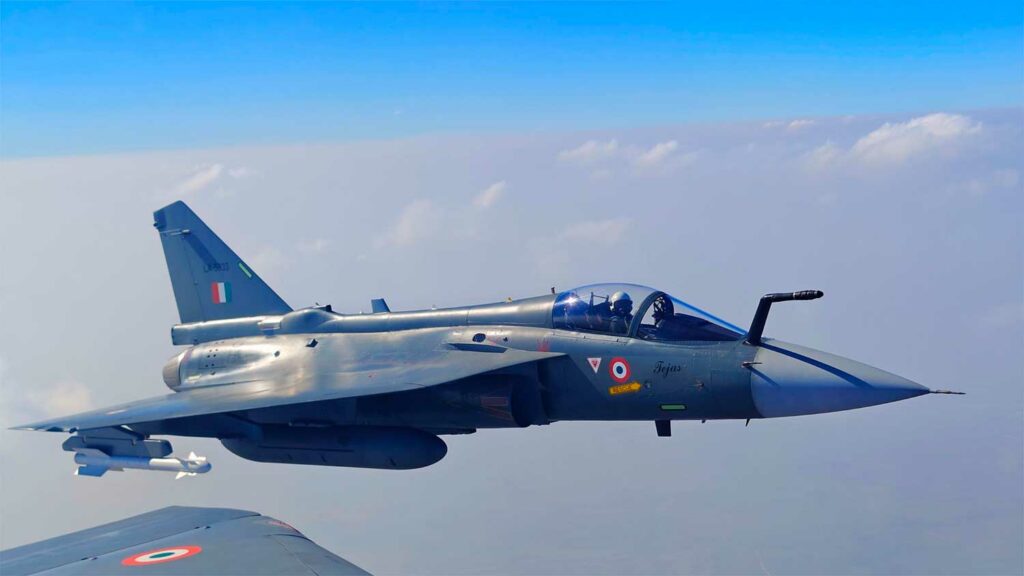
Tejas Mk1A nears delivery to the Indian Air Force, production ramped up in Nashik, GE engines delivered, first units expected in 2025-26.
The Tejas Mk1A fighter is now in the final stages of preparation ahead of its imminent delivery to the Indian Air Force. Designed entirely in India by Hindustan Aeronautics Limited (HAL), it is powered by the American GE F404-IN20 engine. The recently inaugurated production process in Nashik is ramping up. The first units are expected to be delivered between 2025 and 2026. This technical article details the progress, engine integration, schedule, military capabilities, and strategic impact for India.
The Tejas Mk1A program and its industrial challenges
The Tejas Mk1A is an upgraded version of the Mk1, incorporating AESA radar, electronic self-protection, air-to-air refueling capability, and BVR missiles such as the Astra Mk-1. It is part of an initial contract for 83 aircraft signed in 2021 for approximately 365 billion rupees (approximately $4 billion). A second batch of 97 aircraft was approved in 2023, bringing the total to 180 units to be delivered by 2029. This program is part of the “Make in India” initiative aimed at strategic autonomy and the growth of national SMEs.
Initial production took place in Bangalore, with a rate of 8 then 16 units per year. In April 2023, HAL opened a line in Nashik, bringing capacity to 24 aircraft per year, with plans to add a fourth line to reach 32 units per year by mid-2026.
GE engine supply and supply chain management
The GE F404-IN20 engine is essential. A $716 million agreement, signed in 2021, calls for 99 units to be delivered between 2025 and 2029. However, delays have affected deliveries due to supply chain issues, notably affecting a South Korean supplier, pushing back the first delivery to April 2025 instead of March 2024.
Since then, GE has resumed a regular pace of two engines per month until March 2026. Two units were shipped to HAL between April and July 2025. This allows HAL to use engines in rotation for testing, with 12 aircraft scheduled for delivery by March 2026, six of which are confirmed. HAL plans to produce 12 aircraft in 2025 and move to an annual delivery rate of 16 to 24 aircraft from 2026-27 if engine supply remains stable.
The Nashik line: ramp-up and cooperation with the private sector
The Nashik assembly line has been operational since April 2023. It has enabled the launch of the first aircraft scheduled for the end of the 2024-25 financial year, with the first Mk1A aircraft expected in April 2025. In May 2025, VEM Technologies, a subcontractor based in Hyderabad, delivered the first certified center fuselage, marking the establishment of a fourth production line as part of efforts to integrate a local industrial base.
In June, HAL announced that the first aircraft from Nashik will fly in July 2025, followed by a series of four to five aircraft from this line in 2025 and then eight per year thereafter. In July, tests of the Astra Mk-1 missile were scheduled for August, confirming the industrialization of operational capabilities.

Delivery schedule and outlook for the Indian Air Force
HAL’s test commission has approved several aircraft that are ready, despite the wait for the physical engines. At the Aero India 2025 show, Defense Production Secretary Sanjeev Kumar said that the production process had stabilized at HAL and GE, with a target of 16 to 24 deliveries per year starting in fiscal year 2025-26.
HAL has officially confirmed that at least six Tejas Mk1As will be delivered before March 2026 as part of the current fiscal year. The first 12 deliveries are planned for 2025-26, with a steady pace from 2026-27 if GE maintains its rate of two engines per month.
Military capabilities and strategic impact
The Tejas Mk1A is a light, single-engine, multi-role fighter equipped with AESA radar, a complete EW suite, BVR missiles, and air-to-air refueling capability. Its air-to-ground and air defense penetration capabilities make it a suitable replacement for the aging MiG-21s, whose squadron strength has been reduced from 42 to 31.
This fighter reduces technological dependence. Although the first deliveries will incorporate foreign radars, from 2028 onwards the Mk1A generation will use the Uttam AESA radar and 100% indigenous EW systems developed by DRDO. According to HAL, the Tejas Mk1A will be able to compete with the JF-17 and KAI T-50 and become a benchmark in the light combat aircraft category.
Critical reflections and challenges to watch
HAL was severely criticized by the head of the IAF at a trade show, pointing to the absence of the promised aircraft despite the structures being ready; this prompted the industry to react by speeding up internal organization and deliveries. The driving factor remains central: GE has picked up the pace, but a breakdown or delay could seriously impact production rates. HAL could impose contractual penalties on GE if commitments are not met.
In addition, the integration of private subcontractors into the chain (VEM, L&T for the wings) must be consolidated to maintain consistency and quality. Any technical or logistical failure could have a domino effect on delivery times.
The Tejas Mk1A program is effectively on track to enter the delivery phase in 2025, after two years of delays related to the GE engine. The ramp-up of the Nashik production line, the growing integration of local industry, the engine production rate, and the stabilization of testing pave the way for 12 deliveries in 2025-26, followed by 16 to 24 per year from 2026-27. For the Indian Air Force, this is a major turning point in closing the air force gap with China and Pakistan. The main challenge remains GE’s engine supply and the upskilling of Indian subcontractors, without which the schedule could once again be called into question.
War Wings Daily is an independant magazine.